
Lizard is the common name used for all squamate reptiles other than snakes, encompassing over 7,000 species, ranging across all continents except Antarctica, as well as most oceanic island chains. The grouping is paraphyletic as some lizards are more closely related to snakes than they are to other lizards. Lizards range in size from chameleons and geckos a few centimeters long to the 3-meter-long Komodo dragon.

The blue-tailed day gecko is a diurnal species of gecko, a lizard in the family Gekkonidae. The species is endemic to the island Mauritius. It typically inhabits warm and humid places and dwells on different trees and bushes.

Eublepharis is a genus of terrestrial geckos native to eastern and southwestern Asia. The genus was first described by the British zoologist John Edward Gray in 1827. The etymology of their name is 'eu' = good (=true) |'blephar' = eyelid, and all have fully functional eyelids. Members of this genus are found in eastern and southwestern Asia. These geckos are sturdily built. Their tail is shorter than their snout–vent length, and their body is covered with numerous wart-like bumps. The toes do not have adhesive lamellae or membranes. Like all members of Eublepharidae, they are primarily nocturnal. Included in this group is the popular pet leopard gecko Eublepharis macularius.

Naultinus is a genus of geckos that are endemic to New Zealand. On account of their striking colouration, species in the genus Naultinus are commonly known as green geckos. There are nine described species in the genus. Species in the genus share a number of traits that set them apart as quite different from the rest of the world's two thousand odd gecko species, which are generally brown in colour, ovivaparous, short-lived and nocturnal. In contrast, Naultinus are green, ovovivaparous, live up to 30 years or more and are strictly diurnal. New Zealand has a temperate, maritime climate, and in terms of distribution Naultinus is one of the southernmost gecko genera in the world — some species live in habitats in the South Island which receive regular snowfall in winter. Animals in this genus possess several physiological and behavioural adaptations to cope with these periods of low temperatures and adverse weather.

The central bearded dragon, also known as the inland bearded dragon, is a species of agamid lizard found in a wide range of arid to semiarid regions of eastern and central Australia.

Anolis carolinensis or green anole is a tree-dwelling species of anole lizard native to the southeastern United States and introduced to islands in the Pacific and Caribbean. A small to medium-sized lizard, the green anole is a trunk-crown ecomorph and can change its color to several shades from brown to green.
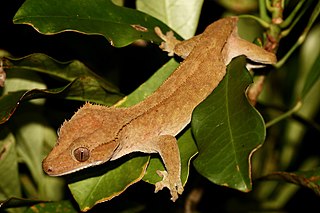
The crested gecko or eyelash gecko is a species of gecko native to southern New Caledonia (France). In 1866, the crested gecko was described by French zoologist Alphonse Guichenot. This species was thought to be extinct until it was rediscovered in 1994 during an expedition led by Robert Seipp. Along with several other New Caledonian gecko species, it is being considered for protected status by the Convention on the International Trade in Endangered Species of Wild Flora and Fauna.

Rhacodactylus leachianus, commonly known as the New Caledonian giant gecko, Leach's giant gecko, leachianus gecko, or simply Leachie, is the largest living species of gecko and a member of the family Diplodactylidae. It is native to most of New Caledonia.
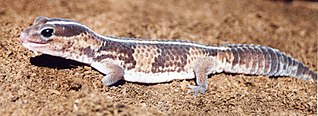
The African fat-tailed gecko or fat-tail gecko is a ground-dwelling species of gecko from West Africa and Cameroon.

Autotomy or 'self-amputation', is the behaviour whereby an animal sheds or discards one or more of its own appendages, usually as a self-defense mechanism to elude a predator's grasp or to distract the predator and thereby allow escape. Some animals have the ability to regenerate the lost body part later. Autotomy has multiple evolutionary origins and is thought to have evolved at least nine times independently in animals. The term was coined in 1883 by Leon Fredericq.
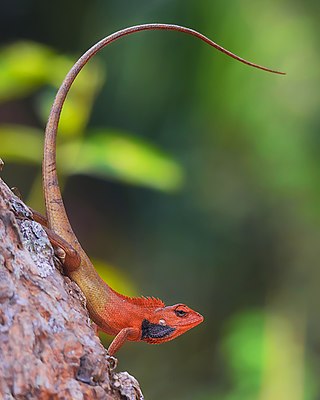
The oriental garden lizard, also called the eastern garden lizard, Indian garden lizard, common garden lizard, bloodsucker or changeable lizard, is an agamid lizard found widely distributed in Indo-Malaya. It has also been introduced in many other parts of the world.
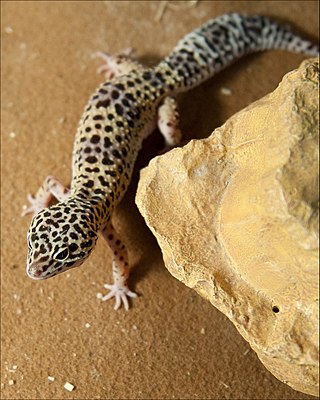
The Afghan leopard gecko is one of the five subspecies of the common leopard gecko, a small to midsized lizard belonging to the family Gekkonidae. This subspecies was first discovered by entomologist Carl Julius Bernhard Börner in 1976. It is much smaller than other leopard gecko subspecies.
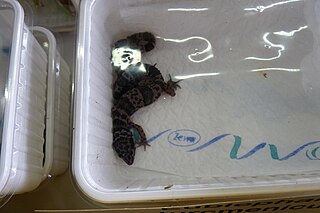
The Turkmenistan eyelid gecko or Turkmenian eyelid gecko is a ground-dwelling lizard native to Turkmenistan and northern Iran. It inhabits rocky and stony foothills and slopes at elevations up to 1,000 m (3,300 ft) above sea level. It is oviparous, typically laying clutches of two eggs. Mainly insectivorous, it may also eat smaller vertebrates. Like many other lizards has the ability to shed its tail (autotomy).

The Eublepharidae are a family of geckos (Gekkota) consisting of 43 described species in six genera. They occur in Asia, Africa, North America, and Central America. Eublepharid geckos lack adhesive toepads and, unlike other geckos, have movable eyelids, thus commonly called eyelid geckos. Like other members of Gekkota, the Eublepharidae exhibits tail autotomy due to the fracture planes near their vent. A new tail will then grow in its place, usually lacking the original color and texture. The muscles in the old tail will continue to flex for up to 30 minutes after the drop to distract predators. Leopard geckos and African fat-tailed geckos are popular pet lizards.
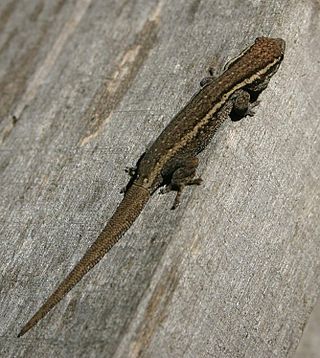
The Cape dwarf gecko ('lygodactylus' = 'flexible fingers') is a species of dwarf gecko found in the woodlands and forests of central and southern Africa. It also occurs commonly in towns and cities and is sometimes kept as a pet.

The marbled leaf-toed gecko is a gecko found in southern and southwestern South Africa and in Namibia. It is a flat, medium-sized gecko.

Gonatodes albogularis, which has been called a number of vernacular names in English, is a smallish species of gecko found in warm parts of Central and South America, Cuba, Hispaniola and Jamaica. They prefer to live in tropical dry forest habitats. It is sexually dimorphic: the male is colourful, while the female is a more drab grey. The fingers do not have lamellar pads for climbing smooth surfaces like many other geckos but instead have normal claws like most lizards. At one time the species had a breeding population in southern Florida, especially Key West, but this population appears to have died out by the early 1990s. They are believed to be able to tell the difference between brightness and hues of conspecifics. Males are incredibly aggressive with territory defense against both other males and potential predators.

Saltuarius salebrosus, also known as the rough-throated leaf-tailed gecko or Central Queensland leaf-tailed gecko, is a gecko found in Australia. It is endemic to dry areas in mid-eastern and south-central Queensland.

Teratoscincus roborowskii, commonly known as the Tibetan wonder gecko or Turpan wonder gecko, is a species of gecko in the family Sphaerodactylidae. The species is endemic to the Turpan Depression in Xinjiang, northwestern China, where it occurs in arid shrubland and desert habitats. It reaches a snout-vent length of 75.5–93.6 mm (3.0–3.7 in), and adult males tend to have wider heads than adult females.
Cryptosporidium varanii is a protozoal parasite that infects the gastrointestinal tract of lizards. C. varanii is often shed in the feces, and transmission is primarily via fecal-oral route. Unlike Cryptosporidium serpentis, C. varanii does not colonize the stomach, but rather the intestines of most infected lizards, such as geckos. An exception to this rule are monitor lizards, as gastric (stomach) lesions have been found in those species. Oocysts of lizard Cryptosporidium are larger than the snake counterpart.





























